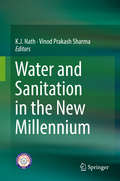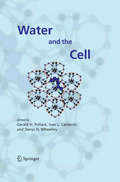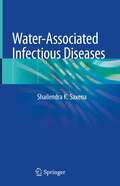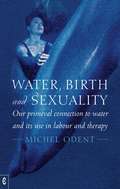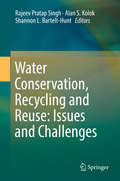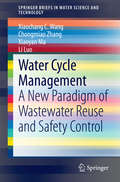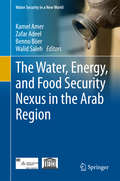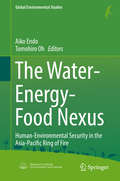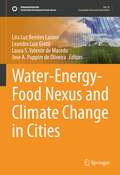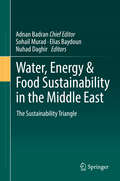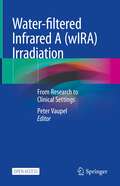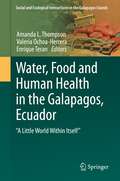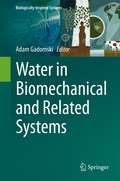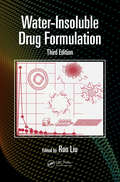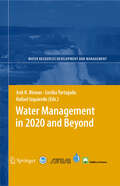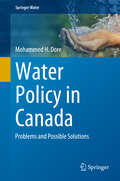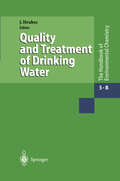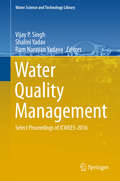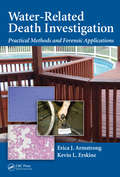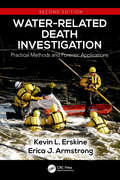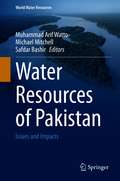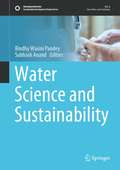- Table View
- List View
Water and Sanitation in the New Millennium
by K. J. Nath Vinod Prakash SharmaThis contributed volume is about water resources, their variability with prevalent environmental conditions and its sustainable management in India.Water has always been the life line for survival. An adequate supply of safe drinking water is one of the major pre-requisites for a healthy life. Time and again water has been a means of consolidating power in the human society. In the beginning of the new millennium, water has become a major issue in India. India is known to have the gift of its unique river systems have abundant water resources but ironically India faces severe water crises and other water management issues on a vast scale. The water related issues in India varies with both time and space. From crises of potable water, lack of sanitation, water borne diseases, to pesticide and heavy metal contamination, water related predicaments are highly prevalent in India and are more grave in rural set up.
Water and the Cell
by Gerald H. Pollack Ivan L. Cameron Denys N. WheatleyThis book deals with the role of water in cell function. Long recognized to be central to cell function, water’s role has not received the attention lately that it deserves. This book brings the role of water front and central. It presents the most recent work of the leading authorities on the subject, culminating in a series of sometimes astonishing observations. This volume will be of interest to a broad audience.
Water-Associated Infectious Diseases
by Shailendra K. SaxenaThis book provides a comprehensive overview of the different water-associated infectious diseases and their linked pathogens with plausible strategies for their mitigation. Although, we are in the era of 21st century having most of the advanced technologies at hand, yet water-associated infectious diseases are the major contributors towards the worldwide morbidity and mortality. The book also focuses on the various implementation strategies of sustainable hygienic conditions, discusses the robust, and reliable policies and strategies on a global aspect to provide unprivileged people access to the basic sanitation, hygiene and water. In addition, the book discusses the possible indirect effect of global warming on the spread of infectious diseases through the distribution of associated vectors.
Water, Birth and Sexuality: Our primeval connection to water, and its use in labour and therapy
by Michel Odent‘After the historic student revolt in France a period of audacious creativity resulted. The watchword was: “It is forbidden to forbid”. We took advantage of this transient cultural folly to do what would have been impossible ten years before or ten years after, introducing in the maternity unit of a state hospital an inflatable outdoor pool as a way to replace drugs during birth.’ – from the IntroductionIn this groundbreaking book, Dr Odent takes as his starting point the world-famous work on childbirth at Pithiviers, where he first noticed the strong attraction to water that many women have during labour. As well as discovering the practical advantages of water during the birthing process, he began to consider the meaning and importance of water as a symbol.Water, Birth and Sexuality examines the living power of water and its erotic connotations. Odent evaluates what water meant in different cultures throughout history, through myths and legends, and what it means for us today: from an advertiser’s tool to a metaphor for aspects of the psyche. He also studies humanity’s special relationship to dolphins, and the related ‘aquatic ape’ theory. A practical section on the use of water during birth and in various therapies, particularly sex therapy, is included.This edition of this classic work features a new Introduction.
Water Conservation, Recycling and Reuse: Issues and Challenges
by Rajeev Pratap Singh Alan S. Kolok Shannon L. Bartelt-HuntWater - a basic element of life, livelihood, food security and sustainable development - holds the key to global sustainability. The global water demand has been increased 3-fold in the past five decades and only 0.4% of the total world’s fresh water resources is available and accessible for use. The United Nations projected that half of all countries will face water scarcity by 2025 and more than one-third of the world’s population could be affected by water stress by 2050. The water problem is rapidly intensifying in the Asian region, and around 700 million people do not have access to safe drinking water. Similarly, according to the Intergovernmental Panel on Climate Change (IPCC) report, by 2050, more than one billion people in Asia alone are projected to experience negative impacts on water resources as a result of climate change. Climate change is also putting extra pressure on and adversely affecting the global water cycle, leading to irregular precipitation, more floods and droughts and creating an imbalance between water supply and demand. The availability of safe water is a major global concern due to the rapidly increasing population, urbanization, unsustainable consumption patterns, and rapid shifts in land use. It is believed that reduced access to freshwater will have cascading consequences that will pose threat to global food security, livelihood security, and cause large scale migration and economic and geopolitical tensions. As such, strategies for water conservation, wastewater reuse and recycling should be adopted in order to lessen the gap between supply and demand for water for different activities. This book provides readers with a better understanding of the water security challenges, and presents innovations to address these challenges, strengthen the science-policy interface, and develop institutional and human capacities for water security and sustainability.
Water Cycle Management: A New Paradigm of Wastewater Reuse and Safety Control (SpringerBriefs in Water Science and Technology)
by Xiaochang C. Wang Chongmiao Zhang Xiaoyan Ma Li LuoThis book focuses on environmental engineering, and on wastewater treatment and reuse in particular, which is a vital aspect for countries and regions suffering from water shortages. It introduces a new water cycle management concept for designing water systems that mimic the hydrological cycle, where reclaimed water is produced, stored/regulated, supplied and used in a semi-natural manner so that its self-purification capacity and system efficiency can be maximized. To ensure safe water throughout the cycle, emphasis is placed on the control of ecological and pathogenic risks using a series of quality indices associated with bioassays and molecular biological analyses, as well as risk assessments focusing on protecting the environment and human health. Together with theoretical and technological discussions, a real case of a district water system for maximizing water circulation and reuse by means of a sophisticated water cycle is presented. This book introduces readers to essential new concepts and practices and illustrates the future perspectives offered by a new paradigm for design and safety control in the context of wastewater reuse systems.
The Water, Energy, and Food Security Nexus in the Arab Region (Water Security in a New World)
by Kamel Amer Zafar Adeel Benno Böer Walid SalehThis book investigates the need for a more open and interdisciplinary dialogue on the nexus of food, water and energy security in the Arab region. It argues that achieving sustainable economic development is irretrievably tied to the security of the water–energy–food nexus, which is in turn essential for bringing about sustained peace. Further, it discusses various approaches to achieving these lofty objectives, and offers the following take-away messages:The Arab region is currently under considerable water stress, and the situation will continue to get worse with a number of global changes – most notably those related to climate and regional water distribution.Viable solutions are available in the Arab region and can be implemented through innovative policies, judicious use of new technologies, and stimulating public opinion.Integration across water, energy, and food sectors is obviously needed but achieving it in practice is extremely challenging.There are some gaps in the scientific understanding but at the same time there is a wealth of data and synthesized information that can guide decision-making.
The Water-Energy-Food Nexus: Human-Environmental Security in the Asia-Pacific Ring of Fire (Global Environmental Studies)
by Aiko Endo Tomohiro OhThis book highlights the water-energy-food nexus as one of the most important and fundamental global environmental issues facing the world. Climate and social changes are putting increased pressure on water, energy and food resources. As water is the central aspect within this cluster, the book focuses on the inherent tradeoffs in water resources between producing/consuming energy and food. In addition, it discusses an inter- and trans-disciplinary approach to understanding the complexity of the water-energy-food nexus system, and creating policy options to reduce the tradeoffs among resources. The content integrates a variety of academic disciplines, including not only the natural sciences (e.g. hydrology, coastal oceanography, costal aquatic bioscience, fisheries, environmental earth science etc.) but also the humanities and social sciences (e.g. marine policy, environmental energy policy, resource governance, policy process theory etc.). The book can be used as a textbook for undergraduate and graduate-level sustainability science courses. Further, its practical content and trans-disciplinary approach to addressing nexus issues with stakeholders offers vital information for practitioners and administrators alike.
Water-Energy-Food Nexus and Climate Change in Cities (Sustainable Development Goals Series)
by Lira Luz Benites Lazaro Leandro Luiz Giatti Laura S. Valente de Macedo Jose A. Puppim de OliveiraThis book aims to contribute to the transdisciplinary study of the water-energy-food (WEF) nexus in cities and to help policy makers adopt a more integrated approach to natural resources management in urban environments to face the challenges and threats of climate change. This approach is based on a multidimensional scientific framework that seeks to understand the complex and non-linear interrelationships and interdependencies between water-energy-food under climate change and to generate solutions to reduce trade-offs among development goals and generate co-benefits that help encourage sustainable development and contribute to the achievement of SDGs, mainly SDG 11 (make cities and human settlements inclusive, safe, resilient and sustainable) and SDG 13 (take urgent action to combat climate change and its impacts).Governing the WEF nexus in cities is one of the greatest resource challenges of our time, as cities consume large amounts of WEF, but one that can also generate relevant alternatives with which to tackle climate change. To help fostering these alternatives, this book analyzes the governance, institutional and political economy factors that determine the effectiveness of the nexus approach and reviews the potential, the benefits and the policy implications of the adoption of the WEF nexus approach at the urban level. Through a series of hands-on cases, chapters in this book present the opportunities of the WEF nexus approach to achieve innovation and transformative change and discuss concrete areas of synergy and policy initiative to raise urban resilience. Water-Energy-Food Nexus and Climate Change in Cities will serve both as a guide for policy makers as well as a useful resource for students and researchers in fields such as urban studies, public health, environmental sciences, energy studies and public policy interested in learning how cities can represent possibilities to navigate and manage sustainability from local to global.
Water, Energy & Food Sustainability in the Middle East: The Sustainability Triangle
by Adnan Badran Sohail Murad Elias Baydoun Nuhad DaghirThis book provides a survey of technologies available to tackle the problems associated with climate change in the energy, water and food security nexus with a special focus on the Middle East. It is divided into three main sections. The energy Section consists of six chapters, the water section of seven chapters and finally the food security section has six chapters. The individual chapters are authored by experts and provide discussions and in-depth views on the current status of each topic.
Water-filtered Infrared A (wIRA) Irradiation: From Research to Clinical Settings
by Peter VaupelThe aim of this open access book is to provide a unique, timely, critical and comprehensive compilation of more than 30 years of robust international experimental and clinical research related to the basic science and therapeutic application of water-filtered infrared-A (wIRA) and hyperthermia in oncology, psychiatry (depression), musculoskeletal disorders, dermatology, infectiology, and surgery. This is an internationally absolutely unique attempt which publication is timely and of great interest in medical as well as in natural sciences. The aim is to enhance communication and advance the use of heat therapy for patient benefit, and to generate an environment in which anyone with an interest in hyperthermia can discuss, collaborate, network, and share events and resources. Productive dialogue and discussion among scientists and practitioners on issues relating to hyperthermia therapy is essential, especially relating to thermal transmission by water-filtered infrared-A (wIRA). The specificity and advantage of this technology is its tolerance by tissue, and its penetration of up to 3 cm allows the delivery of high heat dosages that are relevant across multiple clinical indications. Currently, wIRA is being applied in Austria, Germany, Portugal, Switzerland, The Netherlands, UK and the USA. The authors’ hope is that its use will increase in these countries, and also expand into others. This book will be an invaluable tool for oncologists, surgeons, dermatologists as well as physiotherapists.
Water, Food and Human Health in the Galapagos, Ecuador: "A Little World Within Itself" (Social and Ecological Interactions in the Galapagos Islands)
by Amanda L. Thompson Valeria Ochoa-Herrera Enrique TeranIn this book, we bring together interdisciplinary scholars and clinicians in medicine, public health, anthropology, nutrition, environmental sciences, and geography from the University of North Carolina at Chapel Hill, Universidad San Francisco de Quito, the Ministry of Health and the Hospital Oskar Jandl. Together, these authors provide a comprehensive description of the factors shaping water quality, food availability, and health services on the islands, their implications for human health and well-being, and potential avenues for intervention.
Water in Biomechanical and Related Systems (Biologically-Inspired Systems #17)
by Adam GadomskiThe contributed volume puts emphasis on a superior role of water in (bio)systems exposed to a mechanical stimulus. It is well known that water plays an extraordinary role in our life. It feeds mammalian or other organism after distributing over its whole volume to support certain physiological and locomotive (friction-adhesion) processes to mention but two of them, both of extreme relevance.Water content, not only in the mammalian organism but also in other biosystems such as whether those of soil which is equipped with microbiome or the ones pertinent to plants, having their own natural network of water vessels, is always subjected to a force field.The decisive force field applied to the biosystems makes them biomechanically agitated irrespective of whether they are subjected to external or internal force-field conditions. It ought to be noted that the decisive mechanical factor shows up in a close relation with the space-and-time scale in which it is causing certain specific phenomena to occur.The scale problem, emphasizing the range of action of gravitational force, thus the millimeter or bigger force vs. distance scale, is supposed to enter the so-called macroscale approach to water transportation through soil or plants’ roots system. It is merely related to a percolation problem, which assumes to properly inspect the random network architecture assigned to the biosystems invoked. The capillarity conditions turn out to be of prior importance, and the porous-medium effect has to be treated, and solved in a fairly approximate way.The deeper the scale is penetrated by a force-exerting and hydrated agent the more non-gravitational force fields manifest. This can be envisaged in terms of the corresponding thermodynamic (non-Newtonian) forces, and the phenomena of interest are mostly attributed to suitable changes of the osmotic pressure. In low Reynolds number conditions, thus in the (sub)micrometer distance-scale zone, they are related with the corresponding viscosity changes of the aqueous, e.g. cytoplasmatic solutions, of semi-diluted and concentrated (but also electrolytic) characteristics. For example, they can be observed in articulating systems of mammals, in their skin, and to some extent, in other living beings, such as lizards, geckos or even insects. Through their articulating devices an external mechanical stimulus is transmitted from macro- to nanoscale, wherein the corresponding osmotic-pressure conditions apply.The content of the proposed work can be distributed twofold. First, the biomechanical mammalian-type (or, similar) systems with extraordinary relevance of water for their functioning will be presented, also including a presentation of water itself as a key physicochemical system/medium. Second, the suitably chosen related systems, mainly of soil and plant addressing provenience, will be examined thoroughly. As a common denominator of all of them, it is proposed to look at their hydrophobic and/or (de)hydration effects, and how do they impact on their basic mechanical (and related, such as chemo-mechanical or piezoelectric, etc.) properties. An additional tacit assumption employed throughout the monograph concerns statistical scalability of the presented biosystems which is equivalent to take for granted a certain similarity between local and global system’s properties, mostly those of mechanical nature. The presented work’s chapters also focus on biodiversity and ecological aspects in the world of animals and plants, and the related systems. The chapters’ contents underscore the bioinspiration as the key landmark of the proposed monograph.
Water-Insoluble Drug Formulation
by Ron LiuProperties and Formulation: From Theory to Real-World Application Scientists have attributed more than 40 percent of the failures in new drug development to poor biopharmaceutical properties, particularly water insolubility. Issues surrounding water insolubility can postpone or completely derail important new drug development. Even the much-needed reformulation of currently marketed products can be significantly affected by these challenges. More recently it was reported that the percentage increased to 90% for the candidates of new chemical entities in the discovery stage and 75% for compounds under development. In the most comprehensive resource on the topic, this third edition of Water-Insoluble Drug Formulation brings together a distinguished team of experts to provide the scientific background and step-by-step guidance needed to deal with solubility issues in drug development. Twenty-three chapters systematically describe the detailed discussion on solubility theories, solubility prediction models, the aspects of preformulation, biopharmaceutics, pharmacokinetics, regulatory, and discovery support of water-insoluble drugs to various techniques used in developing delivery systems for water-insoluble drugs. This book includes more than 15 water-insoluble drug delivery systems or technologies, illustrated with case studies and featuring oral and parenteral applications. Highlighting the most current information and data available, this seminal volume reflects the significant progress that has been made in nearly all aspects of this field. The aim of this book is to provide a handy reference for pharmaceutical scientists in the handling of formulation issues related to water-insoluble drugs. In addition, this book may be useful to pharmacy and chemistry undergraduate students and pharmaceutical and biopharmaceutical graduate students to enhance their knowledge in the techniques of drug solubilization and dissolution enhancement.
Water-Insoluble Drug Formulation
by Rong Ron LiuProperties and Formulation: From Theory to Real-World Application Scientists have attributed more than 40 percent of the failures in new drug development to poor biopharmaceutical properties, particularly water insolubility. Issues surrounding water insolubility can postpone or completely derail important new drug development. Even the much-needed reformulation of currently marketed products can be significantly affected by these challenges. More recently it was reported that the percentage increased to 90% for the candidates of new chemical entities in the discovery stage and 75% for compounds under development. In the most comprehensive resource on the topic, this third edition of Water-Insoluble Drug Formulation brings together a distinguished team of experts to provide the scientific background and step-by-step guidance needed to deal with solubility issues in drug development. Twenty-three chapters systematically describe the detailed discussion on solubility theories, solubility prediction models, the aspects of preformulation, biopharmaceutics, pharmacokinetics, regulatory, and discovery support of water-insoluble drugs to various techniques used in developing delivery systems for water-insoluble drugs. This book includes more than 15 water-insoluble drug delivery systems or technologies, illustrated with case studies and featuring oral and parenteral applications. Highlighting the most current information and data available, this seminal volume reflects the significant progress that has been made in nearly all aspects of this field. The aim of this book is to provide a handy reference for pharmaceutical scientists in the handling of formulation issues related to water-insoluble drugs. In addition, this book may be useful to pharmacy and chemistry undergraduate students and pharmaceutical and biopharmaceutical graduate students to enhance their knowledge in the techniques of drug solubilization and dissolution enhancement.
Water Management in 2020 and Beyond (Water Resources Development and Management)
by Asit K. Biswas Cecilia Tortajada Rafael Izquierdo-AvinoWater Policy in Canada: Problems and Possible Solutions (Springer Water)
by Mohammed H. DoreThis book deals with the water policy and management in Canada. It discusses various problems and risks in the fresh and drinking water supply in the second largest country in the world. Mohammed Dore argues that water is underpriced and used wastefully in Canada. In selected case studies, he illustrates the major threats from human activity to Canadian freshwaters and drinking water resources, including manufacturing, mining, oil sands production, animal farming and agricultural use. Selected case studies include reviews of even dramatic incidences, e.g. the Walkerton tragedy of 2000, when 7 people were killed and 200 went onto permanent dialysis treatment because of water contamination with harmful pathogens.The book warns that wastewater treatment standards are often not sufficient, so that many drinking water resources are in peril of wastewater contamination. As most of the water resources are provincial responsibility, the book discusses the water management policies in the different provinces separately. Through a detailed discussion and statistical analyses, it can define water policy and management lessons that emerge from the investigated case studies. It ends by contrasting water policy and practice in Canada with the practice in some European countries.
Water Pollution: Drinking Water and Drinking Water Treatment (The Handbook of Environmental Chemistry #5 / 5B)
by G. Baldauf H. J. Brauch A. Bruchet B. Haist-Gulde J. Mallevialle B. E. Rittmann D. Van Kooij A.M. van Dijk-LooijaardThe concern over the entry of agrochemicals and other xenobiotics into drinking water resources and over the general quality of drinking water is increasing. The topic of water quality and water supply will continue to be of great interest during the next two decades in developed as well as in developing countries. The new volume discusses in an authoritative way the key issues of drinking water and its often necessary treatment.
Water Quality Management: Select Proceedings of ICWEES-2016 (Water Science and Technology Library #79)
by Vijay P Singh Shalini Yadav Ram Narayan YadavaThis book comprises two parts. The first part deals with some aspects of wastewater treatment, encompassing various types of technologies for treating wastewater and evaluation. The technologies, biochemical as well as chemical, including evaluation of technologies are also discussed. Part 2 is on solid waste management. It includes both municipal and industrial waste management. The book is of interest to researchers and practitioners in the field of water resources, hydrology, environmental resources, agricultural engineering, watershed management, earth sciences, as well as those engaged in natural resources planning and management. Graduate students and those wishing to conduct further research in water and environment and their development and management find the book to be of value.
Water-Related Death Investigation: Practical Methods and Forensic Applications
by Kevin L. Erskine Erica J. ArmstrongAll too often, police called to the scene of a water-related death may consider it an accidental drowning before they even arrive. But the investigation of these types of deaths requires the same careful and thorough documentation as in other potentially non-natural deaths and these efforts must be carried through all stages of investigation. Water
Water-Related Death Investigation: Practical Methods and Forensic Applications
by Kevin L. Erskine Erica J. ArmstrongNearly ten years after the first edition of Water-Related Death Investigation: Practical Methods and Forensic Applications, water death cases continue to be improperly investigated. The pathologist’s report can determine the cause of death as a drowning, but the manner of death is the most challenging to prove. The report will not determine if a victim jumped into the water to commit suicide, fell into the water accidentally, or was pushed in as a homicidal act. Many drowning cases do not reflect injury to the body, so evidence collected at the scene plays a vital role. The importance of an on-scene body assessment cannot be overemphasized. Often, the body evidence begins to change rapidly upon recovery and may not be present during an autopsy. Written statements on the scene are an effective tool to use to determine the accuracy of information given to arriving officers. These statements need to be written by the witnesses themselves as well as the reporting person. The "Show Me" technique can also help reveal discrepancies in a person’s version of what occurred as well as aid in providing the most details to an incident as is humanly possible. This second edition includes updated information on the latest technology to assist water death investigators. Parabon Snapshot can help determine the faceless identity of skeletal remains and help locate potential suspects using the science of DNA. Drones can aid in locating missing persons as well as human remains, even months after death. Updated information is provided regarding fingerprints from submerged objects, and Carbon-14 can help determine the origin of a found corpse. Key Features: Thoroughly reviews the physiological aspects of drowning Reveals the investigative characteristics inherent to various scenes of water-related deaths Highlights certain "red flag" indicators that may point to foul play or scene staging Outlines autopsy protocols, trial preparation, and expert witness testimony Provides numerous case studies and numerous illustrations to further clarify key points presented in the text Coauthored by a Master Water Death Investigator and an experienced forensic pathologist, Water-Related Death Investigation: Practical Methods and Forensic Applications, Second Edition merges the essentials of evidence collection and field investigation with autopsy best practices and laboratory testing. It will continue to serve as a valuable resource for the various professionals involved in these cases.
Water-Related Death Investigation: Practical Methods and Forensic Applications
by Kevin L. Erskine Erica J. ArmstrongNearly ten years after the first edition of Water-Related Death Investigation: Practical Methods and Forensic Applications, water death cases continue to be improperly investigated. The pathologist’s report can determine the cause of death as a drowning, but the manner of death is the most challenging to prove. The report will not determine if a victim jumped into the water to commit suicide, fell into the water accidentally, or was pushed in as a homicidal act. Many drowning cases do not reflect injury to the body, so evidence collected at the scene plays a vital role. The importance of an on-scene body assessment cannot be overemphasized. Often, the body evidence begins to change rapidly upon recovery and may not be present during an autopsy. Written statements on the scene are an effective tool to use to determine the accuracy of information given to arriving officers. These statements need to be written by the witnesses themselves as well as the reporting person. The "Show Me" technique can also help reveal discrepancies in a person’s version of what occurred as well as aid in providing the most details to an incident as is humanly possible. This second edition includes updated information on the latest technology to assist water death investigators. Parabon Snapshot can help determine the faceless identity of skeletal remains and help locate potential suspects using the science of DNA. Drones can aid in locating missing persons as well as human remains, even months after death. Updated information is provided regarding fingerprints from submerged objects, and Carbon-14 can help determine the origin of a found corpse. Key Features: Thoroughly reviews the physiological aspects of drowning Reveals the investigative characteristics inherent to various scenes of water-related deaths Highlights certain "red flag" indicators that may point to foul play or scene staging Outlines autopsy protocols, trial preparation, and expert witness testimony Provides numerous case studies and numerous illustrations to further clarify key points presented in the text Coauthored by a Master Water Death Investigator and an experienced forensic pathologist, Water-Related Death Investigation: Practical Methods and Forensic Applications, Second Edition merges the essentials of evidence collection and field investigation with autopsy best practices and laboratory testing. It will continue to serve as a valuable resource for the various professionals involved in these cases.
Water Resources Engineering Risk Assessment (Nato ASI Subseries G: #29)
by Jacques GanoulisAlthough many theoretical developments have been achieved in recent years, the progress both in understanding and application of risk and reliability analysis in water resources and environmental engineering remains slow. One of the reasons seems to be the lack of training of engineers with phenomena of statistical nature, including optimum cost and benefit decisions under uncertainty. This book presents, in a unified and comprehensive framework, the various aspects of risk and reliability in bothwater quantity and quality problems. The topics covered include uncertainty analysis of water quantity and quality data, stochastic simulation of hydrosystems, decision theory under uncertaintyand case studies. Methods for risk analysis of extremes in hydrology, groundwater clean-up, river and coastal pollution as well as total risk management are presented.
Water Resources of Pakistan: Issues and Impacts (World Water Resources #9)
by Muhammad Arif Watto Michael Mitchell Safdar BashirThis book presents the first comprehensive assessment of water resources in Pakistan including surface water resources and groundwater resources. It gives a detailed overview of issues and challenges related to water which have not been adequately addressed e.g. water resource vulnerability to climate change, groundwater depletion and contamination, and water governance etc. It includes a collection and compilation of unpublished and scattered data from the archives and repositories of various national institutions and organization.Given the literature dearth, this book will not only be a comprehensive assessment of water resources in Pakistan but can also can as outstanding textbook on water resource management in Pakistan. It will attract a great range of readership including water specialists, researchers, undergraduate and post graduate students and policy makers from Pakistan as well as from overseas.
Water Science and Sustainability (Sustainable Development Goals Series)
by Bindhy Wasini Pandey Subhash AnandThis book describes the importance of water resources for socio-economic and ecological development including geomorphic and ecological environments. Hence, conservation, management and development of water resources have become necessary for the all-around development of global populations and the environment. It is the outcome of valuable contributions made by eminent scientists and research scholars who have developed alternative strategies, solutions and models for sustainable water resources through research, monitoring and experiments varying from regional to global scale. This book is of immense use to the policymakers, environmentalists, ecologists, academician, research scholars and people in general concerned with water resources management.
